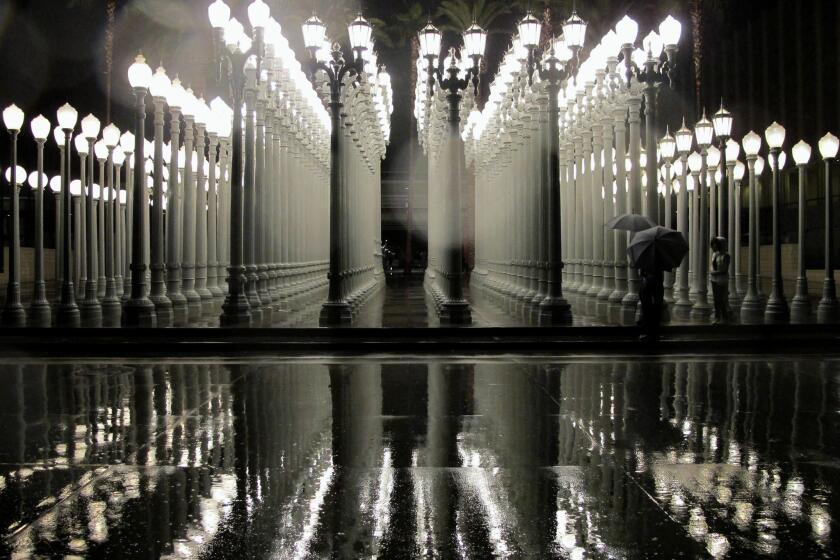How the humble streetlight can make Los Angeles a better city
When I was in college, my father and I once got into a disagreement about streetlights, of all things. To him, they were worthy of no notice, whereas I countered that streetlights, like everything designed by humans, represented an expression of creativity. Late last month, Los Angeles took up my side of the argument.
Using as a backdrop Chris Burden’s LACMA installation “Urban Light” — 202 vintage streetlights, most from Southern California, massed in ranks on Wilshire Boulevard — Mayor Eric Garcetti announced a competition to build a better streetlight. Proposals on three tracks — one professional, from which the new design will be selected, and two student contests — are due in January, with winners to be announced in June. First prize is $70,000, and the prospect that your lamp will light our streets for years to come.
“We need a streetlight that safely illuminates,” Garcetti explains in the competition brief, and one that “at the same time expresses a design sensibility that is unmistakably contemporary — and proudly of, and for, Los Angeles.”
Be still, my heart.
Southern California has a long history of illuminating its roads and sidewalks. As early as the 1880s, electric light standards towering 150 feet were erected in downtown Los Angeles, when the population was still barely in the tens of thousands. These were quickly replaced by lampposts constructed on a more human scale.
L.A. design competition seeks a great lamppost for drivers and pedestrians alike, and not only for the city’s affluent areas this time.
By 1909, the website CityLab recently reported, the early urban theorist Charles Mulford Robinson was waxing poetic about Los Angeles’ lighting system. “The lights are so fine,” he wrote, “the effects on the city so beautiful and so rare in this country, that they deserve all the protection and development you can give them.”
We all know the lamps he is describing, or some of them at least. There’s the Broadway Rose, marked by floral scrollwork on its base, installed downtown during the 1920s; some of them are still standing. There are also the five-globe models that line Pasadena’s Colorado Street Bridge, and the boxy Wilshire specials, intended to resemble lanterns.
In all, Los Angeles has more than 220,000 streetlights, of varying designs. Since the 1950s, the city has relied on a standard aluminum pole with arching arm and, recently, an LED fixture — so utilitarian, it makes my father’s argument without even trying.
There’s a reason for the simplicity: After World War II, Los Angeles sprawled. With the development of the freeways, it became a vast, decentered city in which, as Joan Didion observed in 1989, “a good part of any day … is spent driving, alone, through streets devoid of meaning to the driver, which is one reason the place exhilarates some people, and floods others with an amorphous unease.”
The streets, in other words, have long since been configured to serve the automobile; they are conduits for cars, not multivalent public spaces.
“It took us more than 50 years to redesign the city to favor cars, so we won’t achieve any newfound balance overnight,” the city’s chief design officer (and former Los Angeles Times architecture critic) Christopher Hawthorne told me in an email. “And we need to start holding up every element the city adds to the public realm for new scrutiny along these lines: How can this object help us address the climate crisis? How will it look not just from the point of view of a driver but to a pedestrian, cyclist, bus rider or wheelchair user?”
Reinventing the public right of way in Los Angeles — that’s a lot to hang on streetlights. But it is a key aspect of the city’s design competition. The contest wish list suggests that revamped lamps and lampposts might provide, along with illumination, a way to “accommodate” hardware for shade sails and solar panels, air quality and traffic monitors, and 4G and 5G antennas. The new streetlights may also double as electric vehicle charging stations and feature “space for carefully selected written text, such as poems or descriptions of neighborhood history or nearby architectural landmarks.”
That’s an expansive vision, and I remain a little skeptical about how much streetlights can reasonably be expected to do. I’m wary, say, of what charging stations might mean for parking on already crowded streets.
At the same time, I’m drawn to the conceit that streetlights might become “hat racks” for the city, utilitarian in an unexpected way. Take those shade sails as an example — a necessity in a city where, the mayor recently acknowledged, “shade is an equity issue.”
There’s no doubt the mayor’s right, which makes the next streetlight, among other things, a factor in sustainability. For me, however, the redesign is most important as a reclamation project, a means of reestablishing our connection to the street, an essential building block in the city’s evolution toward density, public transportation, pedestrianism.
Just consider “Urban Light,” a street-level landmark we didn’t know we needed until it became an essential gathering place. The vibrancy of Burden’s vision for those lamps — the playful way they pull in passersby and connect them to the city — reminds us that creativity can assert itself anywhere, even in the familiar beauty of the streetlight.
David L. Ulin is a contributing writer to Opinion.
More to Read
A cure for the common opinion
Get thought-provoking perspectives with our weekly newsletter.
You may occasionally receive promotional content from the Los Angeles Times.











